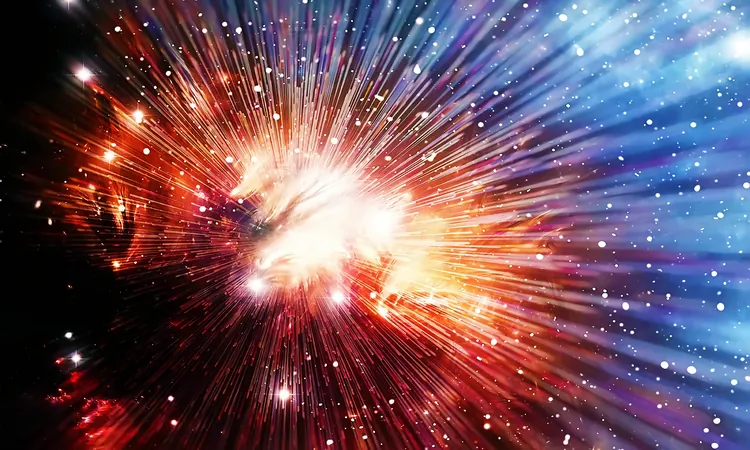
Shocking New Evidence Challenges the Big Bang Theory: Are We Getting the Universe All Wrong?
2024-09-15
In a groundbreaking revelation that could reshape our understanding of the universe, Professor Lior Shamir's recent study has cast a significant shadow over the long-held Big Bang theory. Historically regarded as the cornerstone of cosmology, this theory posits that the universe originated from a singular point approximately 13.8 billion years ago. But new insights from the James Webb Space Telescope (JWST) suggest we might need to take a closer look—or perhaps even rethink how we define our cosmic origins.
Challenging Conventional Wisdom: The Tired Light Theory
Shamir's research, detailed in a recent publication in the journal Particles, provides compelling evidence for the "tired light" theory, a concept that has not received the attention it deserves in over a century. Introduced in the early 20th century, it posits that the redshift observed in distant galaxies—the phenomenon where light shifts to longer wavelengths, giving the impression that galaxies are moving away from us—could be attributed to the light losing energy rather than galaxies receding due to an expanding universe.
Astronomers Edwin Hubble and Georges Lemaître initially observed that distant galaxies appeared to be speeding away from Earth, leading to the acceptance of the Big Bang theory. Yet, Fritz Zwicky, a contemporary thinker, proposed an alternative view: that the light from these galaxies could be diminishing in energy as it traverses the vastness of space, thus creating a false impression of velocity.
Surprising Revelations from the James Webb Space Telescope
The JWST has revolutionized our observational capabilities, delivering unprecedented clarity and depth in its images of the cosmos. Instead of revealing a newborn universe as the Big Bang model would expect, JWST’s first images showcased fully formed, mature galaxies—some that even seem older than the universe itself according to Big Bang timelines.
Shamir emphasizes this unexpected finding: “If the Big Bang happened as initially believed, how can these galaxies exist if they appear to be older than the universe?” This conundrum has prompted a renewed interest in theories like "tired light," suggesting that perhaps our interpretations based on the Big Bang framework are due for reassessment.
Groundbreaking Data on Galaxy Redshift
In conducting his research, Shamir meticulously measured the redshift of over 30,000 galaxies utilizing data from three different telescopes. His findings were remarkable, revealing that galaxies rotating opposite the Milky Way exhibited lower redshifts compared to those moving in sync with it. This pattern, he argues, supports Zwicky's tired light proposition, indicating that redshift could be influenced by distances rather than solely the galaxies' movements.
An Invitation to Rethink Cosmic Origins
While Shamir's findings do not outright dismiss the Big Bang theory, they raise essential questions about its validity. If redshift is not merely a consequence of galaxies fleeing from us, then we must critically examine the fundamental assumptions underpinning one of science's most accepted theories.
These revelations present an intriguing opportunity for scientists to explore alternatives and consider the "tired light" theory's implications on established cosmic phenomena. The challenge becomes: Can we reconcile our observations of ancient galaxies with a universe that has only been around for just over 13 billion years?
In conclusion, Professor Shamir's innovative research invites both the scientific community and the public to rethink their understanding of the universe. As the JWST continues to unveil the mysteries of the cosmos, it seems our quest for knowledge is far from over. The journey into our universe's origins remains an exciting frontier, urging us to welcome new ideas and perspectives that could eventually alter the fabric of cosmological science as we know it.



 Brasil (PT)
Brasil (PT)
 Canada (EN)
Canada (EN)
 Chile (ES)
Chile (ES)
 España (ES)
España (ES)
 France (FR)
France (FR)
 Hong Kong (EN)
Hong Kong (EN)
 Italia (IT)
Italia (IT)
 日本 (JA)
日本 (JA)
 Magyarország (HU)
Magyarország (HU)
 Norge (NO)
Norge (NO)
 Polska (PL)
Polska (PL)
 Schweiz (DE)
Schweiz (DE)
 Singapore (EN)
Singapore (EN)
 Sverige (SV)
Sverige (SV)
 Suomi (FI)
Suomi (FI)
 Türkiye (TR)
Türkiye (TR)